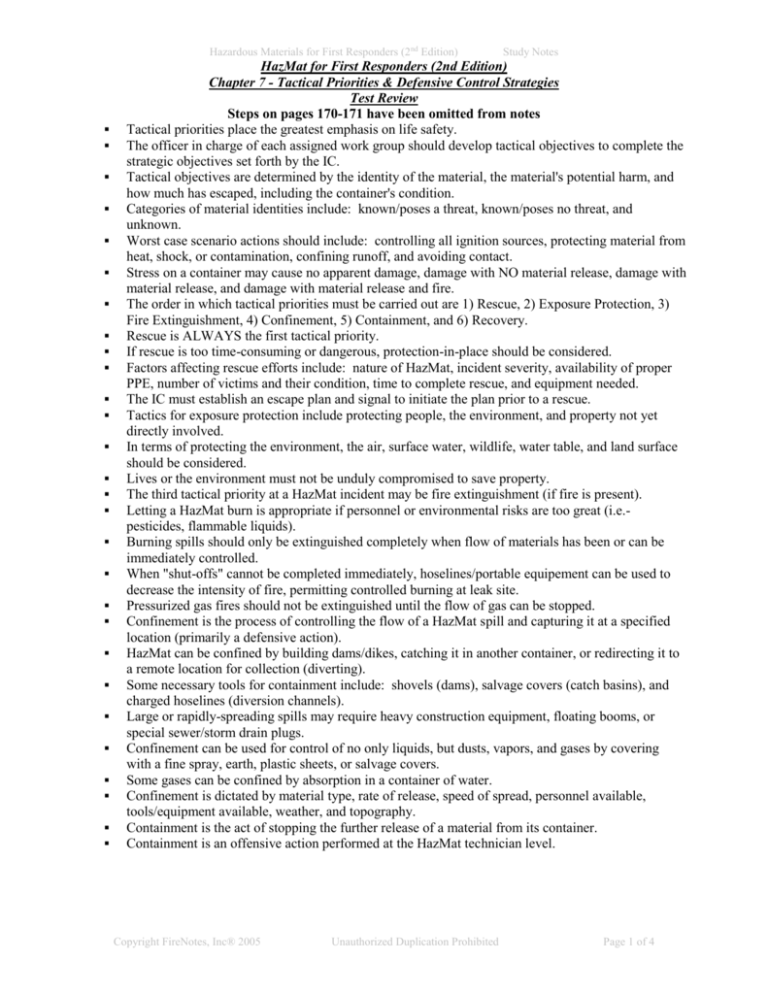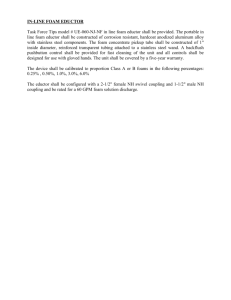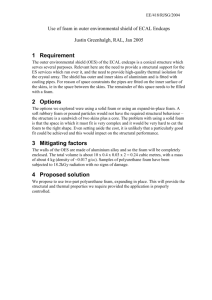HazMat for First Responders (2nd Edition)
advertisement

Hazardous Materials for First Responders (2nd Edition) Study Notes HazMat for First Responders (2nd Edition) Chapter 7 - Tactical Priorities & Defensive Control Strategies Test Review Steps on pages 170-171 have been omitted from notes Tactical priorities place the greatest emphasis on life safety. The officer in charge of each assigned work group should develop tactical objectives to complete the strategic objectives set forth by the IC. Tactical objectives are determined by the identity of the material, the material's potential harm, and how much has escaped, including the container's condition. Categories of material identities include: known/poses a threat, known/poses no threat, and unknown. Worst case scenario actions should include: controlling all ignition sources, protecting material from heat, shock, or contamination, confining runoff, and avoiding contact. Stress on a container may cause no apparent damage, damage with NO material release, damage with material release, and damage with material release and fire. The order in which tactical priorities must be carried out are 1) Rescue, 2) Exposure Protection, 3) Fire Extinguishment, 4) Confinement, 5) Containment, and 6) Recovery. Rescue is ALWAYS the first tactical priority. If rescue is too time-consuming or dangerous, protection-in-place should be considered. Factors affecting rescue efforts include: nature of HazMat, incident severity, availability of proper PPE, number of victims and their condition, time to complete rescue, and equipment needed. The IC must establish an escape plan and signal to initiate the plan prior to a rescue. Tactics for exposure protection include protecting people, the environment, and property not yet directly involved. In terms of protecting the environment, the air, surface water, wildlife, water table, and land surface should be considered. Lives or the environment must not be unduly compromised to save property. The third tactical priority at a HazMat incident may be fire extinguishment (if fire is present). Letting a HazMat burn is appropriate if personnel or environmental risks are too great (i.e.pesticides, flammable liquids). Burning spills should only be extinguished completely when flow of materials has been or can be immediately controlled. When "shut-offs" cannot be completed immediately, hoselines/portable equipement can be used to decrease the intensity of fire, permitting controlled burning at leak site. Pressurized gas fires should not be extinguished until the flow of gas can be stopped. Confinement is the process of controlling the flow of a HazMat spill and capturing it at a specified location (primarily a defensive action). HazMat can be confined by building dams/dikes, catching it in another container, or redirecting it to a remote location for collection (diverting). Some necessary tools for containment include: shovels (dams), salvage covers (catch basins), and charged hoselines (diversion channels). Large or rapidly-spreading spills may require heavy construction equipment, floating booms, or special sewer/storm drain plugs. Confinement can be used for control of no only liquids, but dusts, vapors, and gases by covering with a fine spray, earth, plastic sheets, or salvage covers. Some gases can be confined by absorption in a container of water. Confinement is dictated by material type, rate of release, speed of spread, personnel available, tools/equipment available, weather, and topography. Containment is the act of stopping the further release of a material from its container. Containment is an offensive action performed at the HazMat technician level. Copyright FireNotes, Inc® 2005 Unauthorized Duplication Prohibited Page 1 of 4 Hazardous Materials for First Responders (2nd Edition) Study Notes Containment Factors Can container withstand operation? Condition of Container Will changes in material behavior affect container? Is containment proper if release happens? Will released material contact responders, if so what are risks? speartporPrlaaretaM Is material changing states? Can material be controlled before container is empty? Rate of Release Sufficient resources present for size of breach? Will leaking materials explode or react violently? Incident Assessment Will containment devices hold until recovery operations end? Recovery is the final priority at an incident and includes hazard removal and cleanup. First responders may be needed during cleanup to provide cooling streams, maintaining scene control, or assisting with salvage. Defensive control measures are those which are used to contain and/or confine a material. Defensive Control Actions Physical and/or chemical event occurring during contact between materials that have an attraction for each other Absorption The bulk of material being absorbed enters the structure of the absorbing medium Diatomaceous earth, sawdust, and ground corn cobs are common absorbents Consists of diking, daming, diverting, and retaining Action taken to control flow of liquid HazMat away from point of discharge Dams may be used to permit surface water or runoff ro pass over the dam and hold Confinement HazMat back Diverting away from gutters, drains, storm sewers, flood control channels, and outfalls are common. The application of water to a water-soluble material to reduce the hazard Dilution Effective dilution increases the overall volume and creates a runoff problem Action taken to direct or influence the course of airborne HazMat Vapor Runoff must be confined and analyzed Dispersion Action taken to reduce the emission of vapors at a HazMat spill by applying foam Vapor Water miscible materials such as alcohols, esters, and ketones, require alcohol-resistant Suppression foam for suppression Foam drainage time is the time required for one-fourth of the total liquid solution to drain from the foam. Foam expansion ratio is the volume of finished foam that results from a unit volume of foam solution. The greater the expansion ratio of foam, the thicker the foam blanket. All foams, except fluoroprotein foams, should NOT be plunged directly into a spill. All Class B foams, except special foams made for acids and alkaline spills (no longer produced or sold), may be used for both firefighting and vapor suppression. Water streams should not be used in conjunction with foam application. Foam can NOT seal vapors of boiling liquids (material must be below boiling point). If the film that precedes the foam blanket cannot be seen, as with AFFF, continue to re-apply until spill is covered. Hydrocarbon fuels, such as crude oil, fuel oil, gasoline, benzene, naptha, jet fuel, and kerosene, are petroleum based and float on water. Standard fire fighting foam can float on the surface of hydrocarbon fuels. Polar solvent fuels, such as alcohol, acetone, lacquer thinner, ketones, and esters, are flammable liquids that are miscible in water. Polar solvents require special alcohol-resistant (polymeric) foams. Foam extinguishes and/or prevents fire by smothering (prevents air/flammable vapors from combining), separating (intervenes between fuel and fire), cooling (lowers temperature of fuel and adjacent surfaces), and suppressing (prevents release of flammable vapors). Foam expansion is the ratio of final foam volume to original foam solution volume. Copyright FireNotes, Inc® 2005 Unauthorized Duplication Prohibited Page 2 of 4 Hazardous Materials for First Responders (2nd Edition) Study Notes Foam concentrate is the raw foam liquid before introduction of water and air. Foam proportioners are devices that introduce the correct amount of foam concentrate into the water stream to make the foam solution. Finished foam is the completed product after the foam solution reaches the nozzle and air is introduced into the solution (aeration). Line proportioners and foam nozzles (also called foam makers) are designed to work together. Foams designed solely for hydrocarbon fires will NOT extinguish polar solvent fires at any concentration. Low-expansion foams are also used for vapor suppression on unignited spills. Medium- and high-expansion foams are especially useful for basement, mine shaft, and subterranean fires. Unignited spills require lower application rates because radiant heat, open flame, and thermal drafts are not present to break down the foam. Fire fighting foam concentrate is manufactured with either a synthetic or protein base. Synthetic-based foams are made from a mixture of detergents, while protein foams are derived from plant or animal matter. Subsurface injection is the process of injecting a fluoroprotein foam at the base of a storage tank and allowing it to surface and extinguish the fire. Water from AFFF actually drains from the foam and rests on the surface of the fuel. Alcohol-resistant AFFF creates a membrane, rather than film, over the fuel, that acts as a barrier to prevent attack of the solvent on the foam blanket. Foam Characteristics Type Characteristics Chemically hydrolyzed (broken down) protein (animal) solids Protein For hydrocarbon fires ONLY Must NOT be plunged into the fuel Essentially protein foams that have been fortified with fluorinated surfactants CAN be plunged into the fuel Can be used with fresh or salt water Good water retention and excellent resistance to heat Not affected by freeze/thaw Fluoroprotein Can be stored premixed (short period of time) Maintains low viscosity at low storage/use temperatures Compatible with simultaneous use of dry chemical Can be made alcohol-resistant by adding ammonia salts suspended in organic solvents (alcohol-resistive for about 15 minutes) Not affected by freeze/thaw Can be stored premixed FFFP Compatible with simultaneous use of dry chemical Available in alcohol-resistive form with same regular FFFP capabilities Premixable in portable fire extinguishers and apparatus water tanks Can be freeze-protected with non-flammable anti-freeze solution Good low-temperature viscosity AFFF Air-excluding film floats ahead of foam blanket, resulting in knockdown, and foam blanket follows providing further insulation Alcohol-resistant formulas can be used on hydrocarbon and polar solvent fires Alcohol-resistant AFFF can NOT be premixed HazMat Vapor Designed solely for unignited spills of hazardous liquids Mitigating No longer commercially available Used to extinguish pesticide and concealed space fires, suppress fuming acid vapors, and fixed-extinguishing systems (industrial). Medium/High Not affected by freeze/thaw Expansion Attacks galvanized/raw steel on prolonged contact Use outdoors, generally not recommended due to wind Copyright FireNotes, Inc® 2005 Unauthorized Duplication Prohibited Page 3 of 4 Hazardous Materials for First Responders (2nd Edition) Study Notes The two basic pieces of equipment needed to produce foam are foam proportioner and foam nozzle. Foam proportioners and foam nozzles must match to produce usable foam. Balanced-Pressure and Around-the-Pump proportioners are apparatus mounted units. Foam Proportioners Simplest to use and least expensive No moving parts in the waterway Line Eductors Types: In-line eductor and Self-educting master stream nozzle Use Venturi principle to draft foam concentrate Foam concentrate line is connected to each discharge outlet Balanced-Pressure Concentrate supplied by pump separate from main fire pump Consists of small return line from the discharge side of pump back to the intake side of the pump Around-the-Pump Rated for a specific flow Nozzles designed to add air to the foam solution are called foam nozzles. The most effective appliance for the generation of low-expansion foam is the air-aspirating foam nozzle. Standard fixed-flow fog nozzles are used to produce low-expansion, short-lasting foam, and can NOT be used with protein and fluoroprotein foams or alcohol-resistant FFFP and AFFF foams. Automatic foam nozzles operate like fixed-flow nozzles, providing that the eductor is operated at the inlet pressure for which it was designed (also requires nozzle to be fully open). High-expansion foam generators produce a high-air-content, semi-stable foam. The two basic types of high-expansion foam generators are the mechanical blower and wateraspirating nozzle. Water-aspirating high-expansion foam nozzles are larger and longer than other foam nozzles. High expansion foam nozzles produce a medium expansion foam inside the nozzle before passing it through a screen or series of screens at the end of the nozzle to produce high-expansion foam. The back of high-expansion foam nozzles is an open-design to draw in air. Mechanical blower foam generators resemble smoke ejectors and are typically associated with totalflooding applications. The most common reasons for failure to produce quality foam include: Failure to match eductor with nozzle flow (results in no pickup of concentrate Air leaks at fittings (loss of suction) Improper cleaning (clogged foam passages) Partially closed nozzles (higher nozzle pressure, hence, unmatched pressure) To long a hose lay on discharge side of eductor (excessive backpressure) Kinked hose Nozzle too far above eductor (excessive elevation pressure) Mixing different types of foam concentrate in same tank (incompatibility) Copyright FireNotes, Inc® 2005 Unauthorized Duplication Prohibited Page 4 of 4






